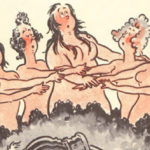 Mysteries
Mysteries  Mysteries
Mysteries  History
History 10 Surprising Stories About the Texas Rangers
 Humans
Humans 10 Philosophers Who Were Driven Mad by Their Own Theories
 Miscellaneous
Miscellaneous 10 Video-Game-Worthy Weapons and Armors from History
 Weird Stuff
Weird Stuff 10 Psychics Who Accurately Predicted Wartime Events
 The Arts
The Arts 10 Pieces of Art Inspired by a Broken Heart
 Health
Health 10 Science Fiction-Sounding New Medical Treatments
 History
History 10 Surprising Facts About the Father of Submarine Warfare
 Space
Space Ten Astonishing New Insights into Alien Worlds
 Weird Stuff
Weird Stuff 10 Bizarre Summer Solstice Rituals Still Practiced Today
 Mysteries
Mysteries Top 10 Haunting Facts About the Ghost Ship MV Alta
 History
History 10 Surprising Stories About the Texas Rangers
 Humans
Humans 10 Philosophers Who Were Driven Mad by Their Own Theories
Who's Behind Listverse?

Jamie Frater
Head Editor
Jamie founded Listverse due to an insatiable desire to share fascinating, obscure, and bizarre facts. He has been a guest speaker on numerous national radio and television stations and is a five time published author.
More About Us Miscellaneous
Miscellaneous 10 Video-Game-Worthy Weapons and Armors from History
 Weird Stuff
Weird Stuff 10 Psychics Who Accurately Predicted Wartime Events
 The Arts
The Arts 10 Pieces of Art Inspired by a Broken Heart
 Health
Health 10 Science Fiction-Sounding New Medical Treatments
 History
History 10 Surprising Facts About the Father of Submarine Warfare
 Space
Space Ten Astonishing New Insights into Alien Worlds
 Weird Stuff
Weird Stuff 10 Bizarre Summer Solstice Rituals Still Practiced Today
10 Movies with Bleak (but Amazing) Endings
The majority of films end on a happy note, with order being re-established in the plot to leave viewers feeling hopeful and satisfied. Sad endings are definitely in the minority, and even rarer are endings that blow past sad and go for full-on devastation. Although these endings typically aren’t crowd-pleasers, they are undeniably impactful, lingering in the viewer’s mind for weeks, months, and even years. Here are 10 fantastic movies that manage to pull off bleak endings. Spoiler warning ahead.
Related: 10 Dark Theories Surrounding Beloved Kids Movies
10 The Fly (1986)
Although often remembered for the squeamish feeling evoked by David Cronenberg’s trademark body horror, The Fly is as emotionally devastating as it is grotesque. Over the course of the movie, we watch as scientist Seth Brundle (Jeff Goldblum) is turned into a human-fly hybrid after his teleportation experiment goes wrong. His transformation—in all its flesh-shedding repulsion—is horrific, but the final scene is also undeniably heart-breaking.
Although Brundlefly has been terrorizing Ronnie (Geena Davis) and others, he’s still as much a victim as he is a villain. Brundlefly doesn’t want to be the bad guy—his monstrous behavior is dictated by DNA changes beyond his control. As he crawls out of the telepod one last time, now turned into a barely functioning human-fly-machine amalgam, he begs to be put out of his misery. In this moment, it’s easy to see—and feel sorry for—the kind scientist buried within the ghastly monster. The Fly may be a horror movie, but it’s also a tragedy.[1]
9 Night of the Living Dead (1968)
George A. Romero’s Night of the Living Dead was the first modern zombie film, and to this day, it’s still one of the most brutal endings in the horror genre. Ben (Duane Jones) manages to survive the zombie-infested night. Still, when he emerges from the basement the next morning to the sound of other survivors, he’s unexpectedly shot dead and thrown onto the bonfire with the zombies.
Duane Jones himself fought for this shocking ending. “I convinced George that the black community would rather see me dead than saved, after all that had gone on, in a corny and symbolically confusing way,” Jones related in the 2010 book Night of the Living Dead: Behind the Scenes of the Most Terrifying Zombie Movie Ever. “The heroes never die in American movies. The jolt of that and the double jolt of the hero figure being black seemed like a double-barreled whammy.”
Romero tells a slightly different story, claiming that despite pressure from the studio, “We couldn’t imagine a happy ending… Everyone wants a Hollywood ending, but we stuck to our guns.” Regardless of who was responsible, the twist ending is both iconic and tragic.[2]
8 Atonement (2007)
Atonement, directed by Joe Wright, is billed as a romantic war movie. But that description does a massive disservice to the miserable gut punch that is its ending. Based on Ian McEwan’s 2001 novel of the same name, the film charts the fraught love story of Robbie (James McAvoy) and Cecilia (Keira Knightley) from the perspective of Cecilia’s younger sister Briony, played at different ages by Saoirse Ronan, Romola Garai, and Vanessa Redgrave.
The audience is led to believe that Robbie and Cecilia were reunited after being torn apart by Briony wrongly testifying that Robbie was a rapist. At the end of the film, it’s revealed that this story is from Briony’s autobiographical novel but that she fictionalized a happy ending for the couple. She admits that in real life, both Robbie and Cecilia died during World War II, so they never reconciled. By writing a happy ending for them, Briony attempts to atone for her life-altering (and ending) mistake, the success of which is debatable.[3]
7 Se7en (1995)
David Fincher’s crime thriller Se7en follows two detectives, Mills (Brad Pitt) and Somerset (Morgan Freeman), as they try to stop a serial killer who is modeling murders on the seven deadly sins. The film ends with the killer successfully drawing Mills into his plan. After it’s revealed that Mills’s wife’s severed head has been delivered in a box, he fails to resist becoming the deadly sin wrath and shoots the killer.
We have Brad Pitt to thank for this bleak ending making it to the screen. After his favorite scene was cut from Legends of the Fall (1994), he had it written into his contract for Se7en that “the head stays in the box” and “he gets to shoot the killer in the end. He doesn’t do the ‘right’ thing, he does the thing of passion.” Pitt’s foresight saved the ending because, after test screenings, the studio did indeed want to soften things by revealing that it was actually a dog’s head in the box and by making Mills heroically resist committing murder.[4]
6 When the Wind Blows (1986)
Based on Raymond Briggs’s graphic novel, Jimmy Murakami’s When the Wind Blows explores the horrors of nuclear war through the eyes of an average elderly couple. Mixing traditional hand-drawn animation with the stop motion of real-life objects, the movie follows Jim and Hilda Bloggs, who live a simple life in the English countryside, as they attempt to survive a nuclear blast.
The couple manages to dive into their inadequate shelter just before the bomb strikes. But Jim and Hilda emerge from their shelter far too early, exposing them to lethal levels of radiation. While their health declines, they both maintain a “Keep Calm and Carry On” attitude, being more worried about the appearance of their house than their imminent demise. That the couple doesn’t fully comprehend their situation makes the events of the film all the more tragic.[5]
5 Oldboy (2003)
When it comes to the best revenge movies of all time, Park Chan-wook’s Oldboy regularly tops lists. Our main character is Dae-su (Choi Min-sik), who is on a quest for vengeance after being imprisoned in a hotel room by someone unknown for 15 years. Where the intriguing plot ends up is not only shockingly disturbing, it’s also deeply depressing.
Dae-su tracks down his captor, Woo-jin (Yoo Ji-tae), but instead of feeling vindicated, it further ruins his life. It’s revealed that Mi-do (Kang Hye-jung), the woman Dae-su has been romantically involved with since his release, is actually his daughter. Woo-jin orchestrated the entire thing because back in high school, Dae-su caught Woo-jin committing incest with his sister, who then killed herself when the information spread around the school. Woo-jin wanted Dae-su to feel the same shame and pain that he did. Dae-su attempts to erase the knowledge of Mi-do being his daughter via hypnosis, but his uneasy smile as they embrace suggests it didn’t take.[6]
4 Grave of the Fireflies (1988)
Studio Ghibli co-founder Isao Takahata’s Grave of the Fireflies is an adaptation of a 1967 short story by Akiyuki Nosaka. The animated film follows siblings Seita and Setsuko as they struggle to survive after the bombing of Kobe in World War II.
In an attempt to lessen the audience’s trauma, Takahata purposefully reveals that both Seita and Setsuko die at the very start of the film. “If an audience knows at the beginning of the film that the two will eventually die, they are more prepared to watch the film in the first place,” he says. “I try to lessen an audience’s pain by revealing everything at the beginning.” But watching the events actually play out is still distressing.
After their mother dies of injuries sustained during the bombing and with their father off fighting in the war (and later assumed to have died), the brother and sister are taken in by their cruel aunt. After her abuse drives them out, the pair slowly succumb to starvation. When Seita learns that his sister is on the verge of death, he uses the last of their money to buy food, but she dies before he can feed her. Seita then later dies of malnutrition himself, surrounded by others suffering the same fate. It’s an incredibly bleak portrayal of war’s consequences on civilians.[7]
3 Threads (1984)
One of the most harrowing pieces of media born from the fear of nuclear war between the United States and the Soviet Union is the 1984 movie Threads. The film is set in Sheffield and follows a young couple who are expecting a baby as the Cold War simmers in the background. When a bomb is finally dropped, the UK is plunged into a nuclear winter, and what follows is so grim that audience members actually walked out during a press screening.
Disease, violence, and starvation plague those who survived the initial destruction caused by the bomb, but Ruth’s baby represents a tiny glimmer of hope. Although society has deteriorated into brutality and misery, that humankind might preserve lingers in the minds of the audience. That is until Ruth’s child, who is now a teenager, gives birth to a disfigured stillborn. Her horror at seeing her dead child—symbolizing that humanity is doomed—is the last shot of this bleaker-than-bleak film.[8]
2 Requiem for a Dream (2000)
Based on Hubert Selby Jr.’s novel Requiem for a Dream (1978), Darren Aronofsky’s film adaptation charts the dismal perils of addiction. We watch as the four main characters—three of whom are addicted to heroin—destroy their lives over the course of the movie. Marion (Jennifer Connelly) unhappily participates in group sex for drugs, Harry’s (Jared Leto) arm is amputated after repeated injections have left it gangrenous, Tyrone (Marlon Wayans) is racially abused in prison while suffering withdrawal symptoms, and Sara (Ellen Burstyn) receives electroshock treatments.
The final scene ends with shots of each character breaking down while lying in the fetal position. Although their stories go in different directions, they all end up traumatized and in the same physical position. The film’s editor, Jay Rabinowitz, told Vulture, “The ending just had no relief. The ramp-up was taking it as far as we possibly could to land on the [four] of them curled up in the fetal position.” He added: “That’s probably somewhat what I looked like by the end of that job.”[9]
1 The Mist (2007)
Frank Darabont’s The Mist is an adaptation of Stephen King’s 1980 novella of the same name, but it completely changes the ending. Both stories follow a father called David (played by Thomas Jane in the movie) as he becomes trapped in a supermarket with his young son after an otherworldly mist filled with Lovecraftian monsters rolls into town. The novella ends on a hopeful note, with a small band of survivors believing that safety can be found after hearing “Hartford” over the car radio.
In the movie, the car runs out of gas, and the survivors decide to shoot themselves rather than be torn apart by the creatures. There are not enough bullets, though, so David is left alive after killing everyone else—including his son. We see him understandably lose his mind, but a few minutes later, the army rolls in to save the day, making David’s situation even more devastating.
In a 2022 interview with Slashfilm, Darabont explained that “I love a happy ending just as much as anybody. It’s satisfying… But if that’s our steady diet, then we’re only eating McDonald’s cheeseburgers. We’re not ever trying something else. It’s limiting us.” Before going down this dark route, Darabont asked King for his permission, and thankfully the author loved the change. “I thought that was terrific,” King said. “And it was so anti-Hollywood—anti-everything, really! It was nihilistic. I liked that.”[10]








